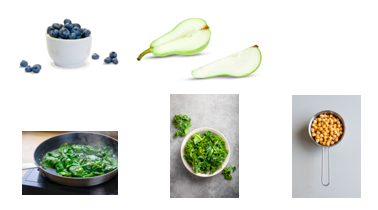by Jenna Koroly, MS, RD, CSOWM, CDN
A nutritious eating pattern including intake of fruits, vegetables, and legumes is recommended to prevent cardiovascular disease (CVD), cancer, and premature death [Yusuf et al., 2020, Ricci et al., 2020., and Aune et al., 2017 as cited in reference i]. Guidelines suggest at least 5 servings daily of fruits, vegetables, and legumes may reduce the risk of CVD [WHO, 2020 as cited in reference i]. The below study explores consumption of these foods in China, where fresh fruit intake may be lower than in western countries, and where vegetables are typically consumed cooked [i].
Study
Fruit, vegetable, and legume intake and the risk of all-cause, cardiovascular, and cancer mortality: A prospective study
Journal: Clinical Nutrition
This prospective study involved 41,243 participants from the Prospective Urban and Rural Epidemiological (PURE) China study. Participants were from 115 different communities in 12 provinces in China. Individuals completed a Food Frequency Questionnaire, physical activity questionnaire, and physical assessment at in-person interviews at baseline. Demographics, socioeconomic status, lifestyle factors, and medical history were also collected. Follow-up was at least every 3 years from the years 2005-2009 to the year 2017. Outcomes included major CVD events, CVD mortality, cancer incidence, cancer mortality, and all-cause mortality [i].
The authors used two models in their statistical analysis: the minimally adjusted model (model 1) adjusted for age, sex, and center as a random effect, and the fully adjusted model (model 2) adjusted for age, sex, center as a random effect, demographics, education level, lifestyle factors, past medical history, waist-to-hip ratio, energy intake, and intake of white meat, red meat, and starch [i].
Findings
The authors found:
1. The average daily intake of fruit, vegetables, and legumes was 2.97 servings
2. Those that consumed more fruits, vegetables, and legumes were more likely to live in urban areas, have higher levels of education, have lower rates of smoking and drinking, and have higher energy intake
3. Higher total intake of fruits, vegetables, and legumes was inversely associated with CVD mortality, cancer incidence, cancer mortality, and all-cause mortality in model 1
4. The association was only seen with total intake of fruits, vegetables, and legumes and all-cause mortality in model 2
5. There was a 27% decreased risk of all-cause mortality with 4-5 daily servings of fruit, vegetables, and legumes, without a further decrease with additional servings
6. Higher intake of fruit alone was inversely associated with CVD mortality, cancer incidence, cancer mortality, and all-cause mortality in model 1. Fruit intake alone (>2 servings per day) was associated with a lower risk of all-cause mortality in model 2
7. Higher intake of vegetables alone was inversely associated with cancer mortality and all-cause mortality in model 1. Vegetable intake alone was not associated with the outcomes in model 2
8. Higher intake of legumes alone was inversely associated with CVD mortality, cancer incidence, cancer mortality, and all-cause mortality in model 1. Legume intake alone (1-2 servings per week) was associated with a lower risk of major CVD events and all-cause mortality in model 2 [i]
For the Patient and Caregiver
In the present study, legumes included beans, lentils, chickpeas, black beans, peas, and black-eyed peas. One serving was defined as 125 g of fruits, 125 g of vegetables, and 150 g of cooked beans. Four to five servings of these foods per day may look like:

Consider how many servings per day you have of fruits, vegetables, and legumes. For tips on how to increase consumption of these nutritious foods, check out our recipes.
For the Healthcare Team
The authors describe that the findings on vegetable intake and cause-specific and all-cause mortality is much more modest than anticipated and differs from findings in other research [Kwok et al., 2019 as cited in reference i]. They assert this is possibly due to vegetable intake falling in a relatively narrow range, differing preparation methods including salt and oil, or grouping vegetables together rather than looking at separate classifications. The results showed individuals were getting about 2/3 of the amount of fruits, vegetables, and legumes found to have a significant impact on the assessed health outcomes (2.97 servings daily compared to 4-5 servings daily). It remains important to encourage patients to aim for at least 4-5 servings of fruits, vegetables, and legumes each day to maintain health and decrease chronic disease risk.
Reference:
[i] Liu W, Hu B, Dehghan M, Mente A, Wang C, Yan R…on behalf of PURE-China Investigators. (2021). Fruit, vegetable, and legume intake and the risk of all-cause, cardiovascular, and cancer mortality: A prospective study. Clinical Nutrition. https://doi.org/10.1016/j.clnut.2021.01.016
